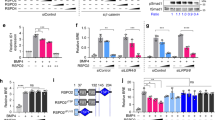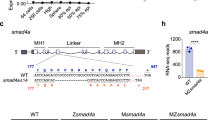Abstract
THE TGF-β/activin/BMP superfamily of growth factors signals through heteromeric receptor complexes of type I and type II serine/threonine kinase receptors1. The signal originated by TGF-β-like molecules appears to be transduced by a set of evolutionarily conserved proteins known as SMADs, which upon activation directly translocate to the nucleus where they may activate transcription2. Five SMAD proteins have so far been characterized in vertebrates1. These factors are related to the mediator of decapentaplegic (dpp) signalling, mothers against dpp (Mad), in Drosophila3 and to the Sma genes from Caenorhabditis elegans4. Smad1 and Smad2 have been shown to mimic the effects of BMP and activin, respectively, both in Xenopus and in mammalian cells2,5–9, whereas Smad3 (a close homologue of Smad2) and the related protein DPC4, a tumour-suppressor gene product10, mediate TGF-β actions11. We report here that DPC4 is essential for the function of Smadl and Smad2 in pathways that signal mesoderm induction and patterning in Xenopus embryos, as well as antimitogenic and transcriptional responses in breast epithelial cells. DPC4 associates with Smadl in response to BMP and with Smad2 in response to activin or TGF-β. DPC4 is therefore a regulated partner of SMADs that function in different signalling pathways of the TGF-β family.
This is a preview of subscription content, access via your institution
Access options
Subscribe to this journal
Receive 51 print issues and online access
$199.00 per year
only $3.90 per issue
Buy this article
- Purchase on Springer Link
- Instant access to full article PDF
Prices may be subject to local taxes which are calculated during checkout
Similar content being viewed by others
References
Massagué, J. Cell 85, 947–950 (1996).
Liu, F. et al. Nature 381, 622–623 (1996).
Sekelsky, J. J., Newfeld, S. J., Raftery, L. A., Chartoff, E. H. & Gelbart, W. M. Genetics 139, 1347–1358 (1995).
Savage, C. et al. Proc. Natl Acad. Sci. USA 93, 790–794 (1996).
Graff, J. M., Bansal, A. & Melton, D. A. Cell 85, 479–487 (1996).
Hoodless, P. A. et al. Cell 85, 489–500 (1996).
Thomsen, G. Development 122, 2359–2366 (1996).
Baker, J. & Harland, R. M. Genes Dev. 10, 1880–1889 (1996).
Eppert, K. et al. Cell 86, 543–552 (1996).
Hahn, S. A. et al. Science 271, 350–353 (1996).
Zhang, Y., Feng, X.-H., Wu, R.-Y. & Derynck, R. Nature 383, 168–172 (1996).
Cárcamo, J. et al. Mol. Cell. Biol. 14, 3810–3821 (1994).
ten Dijke, P. et al. Oncogene 8, 2879–2887 (1993).
Hemmati-Brivanlou, A. & Melton, D. A. Nature 359, 609–614 (1992).
Smith, J. C., Price, B. M. J., Van Nimmen, K. & Huylebroeck, D. Nature 345, 729–731 (1990).
Asashima, M. et al. Roux's Arch. Dev. Biol. 198, 330–335 (1990).
Sokol, S., Wong, G. G. & Melton, D. A. Science 249, 561–564 (1990).
Thomsen, G. H. & Melton, D. A. Cell 74, 433–441 (1993).
Hogan, B. L. M. Genes Dev. 10, 1580–1594 (1996).
Smith, J. C., Price, B. M. J., Green, J. B. A., Weigel, D. & Herrmann, B. G. Cell 67, 79–87 (1991).
Attisano, L., Wrana, J. L., Montalvo, E. & Massagué, J. Mol. Cell. Biol. 16, 1066–1073 (1996).
Whitman, M. & Melton, D. A. Nature 357, 252–254 (1992).
Gawantka, V., Delius, H., Hirschfeld, K., Blumenstock, C. & Niehrs, C. EMBO J. 14, 6268–6279 (1995).
Schutte, M. et al. Cancer Res. 56, 2527–2530 (1996).
Yingling, J. M. et al. Proc. Natl Acad. Sci. USA 93, 8940–8944 (1996).
Liu, F., Ventura, F., Doody, J. & Massagué, J. Mol. Cell. Biol. 15, 3479–3486 (1995).
Wilson, P. A. & Melton, D. A. Curr. Biol. 4, 676–686 (1994).
Harland, R. M. in Methods in Cell Biology (eds Kay, B. K. & Peng, H. B.) (Academic, San Diego, 1991).
Wrana, J. L., Attisano, L., Wieser, R., Ventura, F. & Massagué, J. Nature 370, 341–347 (1994).
Author information
Authors and Affiliations
Rights and permissions
About this article
Cite this article
Lagna, G., Hata, A., Hemmati-Brivanlou, A. et al. Partnership between DPC4 and SMAD proteins in TGF-β signalling pathways. Nature 383, 832–836 (1996). https://doi.org/10.1038/383832a0
Received:
Accepted:
Issue Date:
DOI: https://doi.org/10.1038/383832a0
This article is cited by
-
A lncRNA Dleu2-encoded peptide relieves autoimmunity by facilitating Smad3-mediated Treg induction
EMBO Reports (2024)
-
Evaluation of Long Non-coding RNA Expression Profiles in Peripheral Blood Mononuclear Cells of Patients with Parkinson’s Disease
Molecular Neurobiology (2023)
-
A review: hippo signaling pathway promotes tumor invasion and metastasis by regulating target gene expression
Journal of Cancer Research and Clinical Oncology (2021)
-
Both TGF-β1 and Smad4 regulate type I collagen expression in the muscle of grass carp, Ctenopharyngodon idella
Fish Physiology and Biochemistry (2021)
-
Tbx2 mediates dorsal patterning and germ layer suppression through inhibition of BMP/GDF and Activin/Nodal signaling
BMC Molecular and Cell Biology (2020)
Comments
By submitting a comment you agree to abide by our Terms and Community Guidelines. If you find something abusive or that does not comply with our terms or guidelines please flag it as inappropriate.



